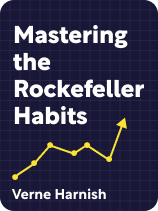

This article is an excerpt from the Shortform book guide to "Mastering the Rockefeller Habits" by Verne Harnish. Shortform has the world's best summaries and analyses of books you should be reading.
Like this article? Sign up for a free trial here.
What made John D. Rockefeller the wealthiest person in history? Which of his business practices can modern leaders apply to their own companies?
In Mastering the Rockefeller Habits, Verne Harnish reveals three fundamental business practices that helped Rockefeller build his empire. These habits—focusing on purpose, tracking progress objectively, and conducting effective meetings—can help any organization maintain health during periods of growth.
Keep reading to learn time-tested principles that can transform your business into a thriving, long-lasting enterprise.
Overview of Mastering the Rockefeller Habits by Verne Harnish
The oil tycoon John D. Rockefeller was—and still is—the richest person in history. He made his fortune by founding the Standard Oil Company and growing it into a mind-bogglingly large multinational corporation. According to entrepreneur Verne Harnish, Rockefeller grew his company using simple fundamentals of business management that any leader can use to optimize their business and maintain organizational health during chaotic periods of growth.
In his 2002 book Mastering the Rockefeller Habits, Verne Harnish sums up the secrets to business success with three habitual business practices that he drew from Titan, a biography of Rockefeller. These three “Rockefeller Habits” are Focusing on a Purpose, Tracking Progress Objectively, and Conducting Effective Meetings. (Harnish refers to these habits as Priorities, Data, and Rhythm, respectively.)
(Shortform note: In Scaling Up, Harnish expands this list of three Rockefeller Habits into a list of 10. Most of these 10 items comprise other advice included in Mastering the Rockefeller Habits that we’ll discuss later in this overview, such as the suggestion to constantly solicit constructive feedback from employees. In Scaling Up, he attributes all 10 of these ideas to Rockefeller—although he doesn’t in Mastering the Rockefeller Habits.)
Harnish is the founder of the Entrepreneurs’ Organization (formerly the Young Entrepreneurs’ Organization), a nonprofit that offers educational resources and networking opportunities to entrepreneurs around the world. He also founded Scaling Up, a company that offers business consulting and educational courses to teams and leaders. His book Scaling Up, also called Mastering the Rockefeller Habits 2.0, serves as a revised version of Mastering the Rockefeller Habits and features advice on many of the same topics.
In this overview, we’ll explain how to manage a business so that it survives and thrives across multiple decades. We’ll begin by explaining how to plan for the long term of 10 to 25 years by aligning yourself with Core Values and pursuing a wildly ambitious goal. Then, we’ll narrow our scope to the medium term of three to 12 months, in which your business should build a competitive advantage by capitalizing on its Unique Value. We’ll then explain what goes into successful short-term planning for the upcoming year, focusing on the use of data to guide strategy. Finally, we’ll discuss how everyone in the company can plan to be the most productive on a day-by-day basis, through the use of daily and weekly meetings.
The Long Term: Your Core Values and BHAG
The first Rockefeller Habit is Focusing on a Purpose. According to Harnish, to make your business a success, you must decide on a long-term goal you want the business to accomplish. Then, ensure that everyone in the company understands and focuses on the single most productive thing they can do to help reach that goal.
To know what long-term mission you want your business to accomplish, you must become fully aware of your business’s Core Values, argues Harnish. These values describe your business’s internal code of ethics: What should the company do, and what shouldn’t it do? What kinds of work are worth pursuing? For example, an auto parts manufacturer’s core values might include absolute dependability, creative problem-solving, and positive environmental impact.
Every company has a set of implicit Core Values, but you can’t properly align the company under this unifying direction until you become consciously aware of what they are. To identify your company’s Core Values, Harnish recommends collaborating with trusted leaders in your company to create a list of three model employees who represent the best parts of your company’s culture. Then, talk about these ideal employees and try to identify what makes them such good team members.
Set a BHAG to Inspire Your Team
We’ve stated that companies that Focus on a Purpose are pursuing a long-term goal. Harnish elaborates that they should specifically be pursuing a “Big Hairy Audacious Goal,” or BHAG. This is an objective, measurable task you intend to accomplish in the next 10 to 25 years that aligns with your company’s Core Values.
Almost nothing is completely impossible on a timeframe as long as this one, so you’re free to set extremely ambitious, ridiculous-sounding goals. Dreaming big makes it easier to inspire people to work toward achieving those dreams—everyone wants to have a significant impact on the world. For instance, a company that makes healthy soft drinks could make it their BHAG to put Coca-Cola out of business by the year 2045.
The Medium Term: Your Unique Value
It’s not enough to identify your company’s BHAG—you also need to come up with a plan for how to get there. To do this, Harnish says that you need to determine what Unique Value your company and (currently) no one else can deliver to the customer (Harnish calls this your Brand Promise). For example, a private tutoring service’s Unique Value could be helping young students build motivation skills, so they want to spend time studying.
Harnish explains that your Unique Value helps your business succeed by giving it a competitive advantage. If you build your business strategy around your Unique Value, you can dominate a competitive market.
Harnish says that to come up with a strategy that will maximize your competitive advantage, ask yourself: How can you give your company sole control over your Unique Value for as long as possible? In other words, what can you do to prevent your competitors from copying your Unique Value? For instance, our tutoring company could extend enticing internship offers to all students at local universities interested in a tutoring career, then provide them with an internal career path. This way, there would be fewer skilled candidates available to work at other local tutoring companies.
How to Identify Your Unique Value
According to Harnish, identifying your unique value and building the capacity to capitalize on it is a significant undertaking that typically takes a company three to five years to accomplish. The first step is to identify what target market you intend to serve over the next three to five years: Who do you want your company to impact? How many customers do you want, and how large of a geographical area will you cover? (Harnish refers to these aspects of your target market collectively as your “Sandbox”).
Once you’ve identified your target market, brainstorm what Unique Value you’re going to offer by asking yourself what these specific customers need. Harnish notes that your Unique Value will only be a profitable advantage if you focus on fulfilling one big customer desire—what they need rather than the countless little things they want. For instance, clients of the aforementioned tutoring company might want flexible scheduling, but they need to boost their child’s academic performance. For this reason, the company would prioritize imparting key motivation skills over perfecting their tutor scheduling systems.
The Short Term: Guiding Metrics
Harnish argues that, in addition to Focusing on a Purpose, successful companies need to practice the Rockefeller Habit of Tracking Progress Objectively: Create ways to measure the company’s financial health and progress toward its goals. Keeping a close eye on this data will help guide your strategic decisions in the short term.
Harnish recommends you primarily focus on tracking two types of data: Profitability Indicators and Target Metrics.
Type #1: Profitability Indicators
First, identify metrics that give a clear impression of your company’s financial health and general productivity. We’ll call these metrics “Profitability Indicators” (Harnish refers to them as “Smart Numbers”). For example, a social media platform’s Profitability Indicators could be the percentage change in the number of new users this week compared to last week, the ROI for this week’s advertisements, and the percentage of users who used the social media platform every day.
According to Harnish, studying your company’s Profitability Indicators in real time allows you to detect rapidly changing market conditions and unforeseen budget problems caused by your company’s growth. Unless you have systems in place to collect and review these Indicators regularly, it’s impossible to adapt your strategy quickly enough to handle these sudden problems.
Discerning which metrics to track requires some experimentation—start by gathering all data you think might accurately predict your future performance. Over time, focus on those metrics that yield the most effective predictions.
Type #2: Target Metrics
In addition to Profitability Indicators that measure the company’s broad financial health, Harnish recommends tracking Target Metrics that measure the company’s short-term progress toward long-term goals (which Harnish calls “Critical Numbers”). Every year, decide on a new quantifiable Target Metric that reflects significant progress toward your BHAG. Likewise, every quarter, set a smaller Target Metric that marks significant progress toward the year’s Target Metric. This ensures that everyone in the company is always unified in their top priorities.
For example, if a healthy soft drink company is trying to drive Coca-Cola out of business, their Target Metric for one year might be to sell 150% more units than the previous year, and one of their quarterly Target Metrics leading to this goal could be to invest in supply chain infrastructure to lower manufacturing cost by 30% (allowing them to lower the retail price and sell more units).
Create Fun Quarterly Themes
In addition to setting a quarterly Target Metric, Harnish recommends creating an exciting theme for every quarter that drives home the Core Values behind your quarterly target—and makes achieving it more fun. Then, when your team hits their target, give them a reward that fits the theme. The reason quarterly rewards are enticing isn’t because the reward itself is practical or valuable. Rather, they allow the team to look forward to the satisfaction of celebrating their victories.
For example, if our soft drink company is trying to streamline their supply chain this quarter, their theme could be “Pass the Ball!” with soccer-themed posters in which different players represent stages of the supply chain. This soccer imagery could also reinforce the Core Values of teamwork and camaraderie. At the end of the quarter, the team could be rewarded with a new foosball table in the break room and a celebratory foosball tournament.
Keep Your Target Metrics Focused and Visible
Harnish recommends restricting these Target Metrics to one area of improvement at a time rather than trying to improve every aspect of your business at once. Organizations make progress much more quickly when they focus all their efforts on a narrow goal.
Additionally, writes Harnish, display these metrics prominently, with large visuals, in a communal space. Employees are more engaged when they can clearly see the effects of their work.
Today: Focused Daily and Weekly Meetings
The final Rockefeller Habit is Conducting Effective Meetings. While many companies see meetings as recurring drains of time and productivity, Harnish asserts that frequent meetings greatly accelerate your progress—as long as you run them the right way. Every meeting should have a predefined agenda and a strict time limit to ensure it’s not wasting anybody’s time.
Harnish says that most companies already run effective quarterly and annual meetings in which they brainstorm major goals and how to achieve them. However, many of those companies neglect effective daily and weekly meetings, which Harnish asserts are just as necessary to accomplish your mission.
Daily Meetings
According to Harnish, everyone in the company needs to attend a meeting every day for five to 15 minutes. They don’t have to meet with the whole organization, but they at least need to meet with their most relevant coworkers. In these meetings, they can clarify what problems need to be solved today and ensure that everyone has the information they need to solve them.
To this end, Harnish contends that daily meetings should follow a three-item agenda: First, each team member quickly sums up what they’re doing today. Giving everyone a basic awareness of what their coworkers are doing helps coordinate collaboration and clear up any conflicts.
Second, the team reviews the latest daily Profitability Indicators. Staying continuously aware of these metrics helps everyone adapt their strategies to sudden changes.
Last, anyone who has an obstacle preventing them from making progress announces it to the rest of the team. Harnish asserts that this is the most important part of the meeting because it focuses everyone’s attention on the most productive kind of work: resolving blockages that prevent people from working optimally.
Weekly Meetings
Next, Harnish argues that everyone in the company should meet with relevant coworkers every week for 30 to 60 minutes. As in daily meetings, weekly meetings should follow a specific agenda.
Item #1: Celebrate
First, team members share any good news that’s happened to them recently, whether at work or in their personal lives. According to Harnish, this will boost everyone’s mood, setting the stage for a productive meeting.
Item #2: Review Suggestions for Improvement
Second, the team reviews suggestions from employees or customers regarding how the business could improve. Harnish suggests picking a recurring problem and assigning someone to investigate and try to solve it in the upcoming week. Even if you’re only able to solve a tiny problem each week, if your solution lasts, those improvements are cumulative. For instance, if a coding team complains that an automated email list bombards them with messages that aren’t relevant to them, you could assign someone to take their team off the company-wide email list. Fix enough little problems like this, and you’ll have radically transformed your company.
To learn what recurring problems are hurting your business, Harnish recommends sending out surveys to every employee asking what the company could be doing better for them—and for customers. Then, set up a system that allows employees to submit feedback at any time, and encourage them to do so for every issue they encounter, no matter how small. Do the same for your customers. This way, you’ll always have feedback to review and act upon in every weekly meeting.
Item #3: Review Profitability Indicators
Next, Harnish explains that the team reviews more detailed Profitability Indicators than those you review in daily meetings. In particular, gauge how much progress you’ve made toward the company’s quarterly goals. As in daily meetings, this big-picture awareness of the company will help people set smarter strategies as they work.
Item #4: Strategize About Weekly Goals
Last, Harnish advises the team to use the bulk of the meeting to discuss strategy. Specifically, identify a narrow subgoal that will help you achieve your themed quarterly target, and open the floor for suggestions on how to accomplish it. For example, if your quarterly goal is to lower your manufacturing costs by 30%, at one weekly meeting you could brainstorm ways to reduce your transportation expenses. Limit yourself to discussing a narrow subtopic like this each week to give yourself the dedicated time needed to dive deeply into the topic at hand.

———End of Preview———
Like what you just read? Read the rest of the world's best book summary and analysis of Verne Harnish's "Mastering the Rockefeller Habits" at Shortform.
Here's what you'll find in our full Mastering the Rockefeller Habits summary:
- What an oil tycoon can teach you about business
- How knowing your business’s unique value is key to beating the competition
- Why you should create fun themes for your quarterly goals






